(email exchange)
Yes,
War!
Race to the bottom!
Whoever inflates the most wins!
>
> On Fri, Dec 19, 2008 at 2:26 PM, CLIFFORD wrote:
>
> THE EURO IS REACTING!!!
>
- Euro (Released n/a EST)
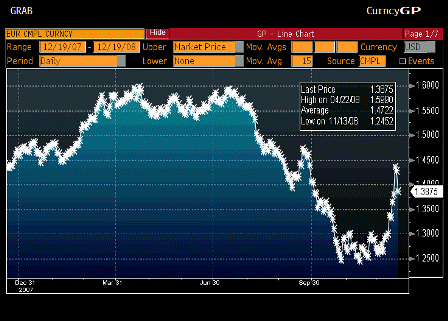
Euro (Dec 19)
[top]

Thanks, Jim.
Now consider this- the main thing interest rate policy does is move income between savers and borrowers.
For example, in the last year or so savers have gone from earning maybe 4.5% to something near 0 today. And borrowers (and lenders making larger spreads) have equally benefited.
So what I’m getting at is the Fed has the authority to shift mega sums from savers to borrowers, and vice versa.
That’s like giving the social security commissioner the authority to raise payroll taxes and pay out more benefits, etc.
Not to mention the swap line authority where the fed can lend unlimited sums to foreign governments, and on an unsecured basis as well.
The real ‘power’ of the Fed is with these powers of distribution, which far outweigh the generally perceived power of altering the macro economy via changes in interbank interest rates.
[top]
Wednesday, December 17, 2008 @ 10:20 EST
Houston Area: Houston 1110 AM KTEK
Dallas / Fort Worth Area: DFW 1110 AM KJSA
[top]

| Survey | n/a |
| Actual | 2.9% |
| Prior | -7.1% |
| Revised | -4.7% |

| Survey | n/a |
| Actual | 286.10 |
| Prior | 299.60 |
| Revised | n/a |
Down some, but still off the lows.

| Survey | n/a |
| Actual | 4156.00 |
| Prior | 3901.90 |
| Revised | n/a |
Up and should move up further with lower rates.
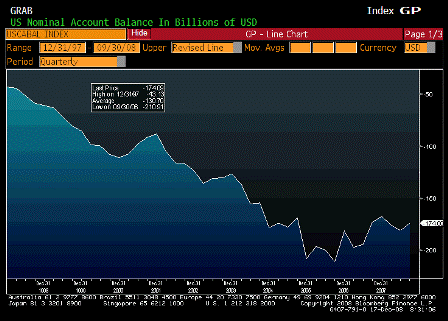
| Survey | -$179.0B |
| Actual | -$174.1B |
| Prior | -$183.1B |
| Revised | -$180.9B |
Worse than expected but looks to still be working its way lower.
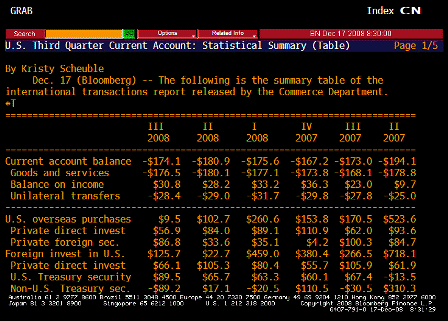
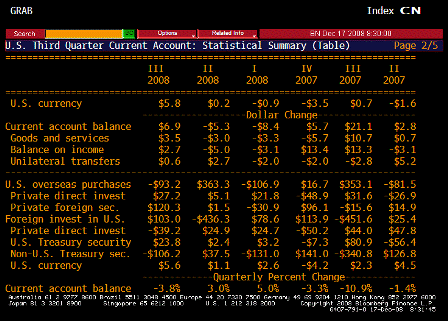
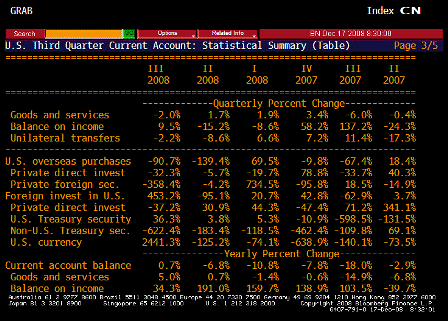
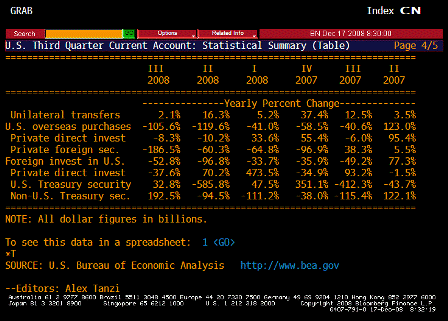
[top]
U.S. Government Releases FY 2008 Financial Report
Washington – The Treasury Department and the Office of Management and Budget today released the Fiscal Year 2008 Financial Report of the United States Government. The report details the U.S. government’s current financial position, as well as its short-term and long-term financial outlook, complementing the President’s Budget to be released in the spring of 2009.
“Throughout this unprecedented year, the Treasury Department has worked to achieve and maintain the stability of the financial system with short-term actions, but we must not forget the long-term needs that pose a significant threat to our country’s fiscal sustainability,” said Treasury Secretary Henry M. Paulson, Jr. “The projected costs for Medicare, Medicaid and other social programs are much greater than the resources that will be available to pay for them. Changes are needed to ensure these programs are fiscally sustainable.”
Just in case you thought Paulson knew something about reserve accounting and monetary operations.
“It is without question that we face extraordinary challenges in our financial markets and the larger economy,” said OMB Director Jim Nussle. “As a result, the bottom-line budget results in the short-term are sobering. It is imperative to continue to aggressively confront today’s challenges. Functioning markets and a healthy economy will not only help put the federal budget back on a path towards balance, but will position us to take on inevitable future economic challenges, such as the our nation’s biggest budgetary challenge, the entitlement crisis.”
At least Nussle ducks the S word (sustainable).
I suspect he knows sustainability isn’t an issue.
And that government deficits equal non government savings of USD financial assets, etc.
[top]
Warren Mosler is away on vacation with very limited Internet access.
He will write and comment as much as possible.
Returning date is December 15th.
Thank you for your patience!
:)
This sounds like they get it and are on it.
It also seems the weak yuan policy is back, as Paulson’s influence fades.
Paulson’s ‘beggar they neighbor’ weak dollar policy caused the US slowdown to spread worldwide.
Govt to increase spending power of rural residents
By Fu Yu
The Chinese government has reaffirmed its commitment to stabilizing the real estate and stock markets, and to boost auto sales.
The National Bureau of Statistics director Ma Jiantang said in a published article that the government would eliminate “consumption bottlenecks” to promote consumer demand. In the article published in Qiushi, a Communist Party journal, Ma wrote that the government would try to increase the spending power of lower income groups and to raise the desire to consume among the well-to-do.
The government has also planned to raise agricultural produce prices to help increase rural income levels. In addition, it will raise subsidies on seeding and farm machinery, and to increase some social benefits to farmers and low-salary rural workers.
In his analysis, Ma said consumers in rural areas have a strong potential demand for a wide range of consumer products and services.
He believes the $586 billion economic stimulus package will have the effect of encouraging increased spending by higher-income consumers, which will help boost investment.
[top]
Note the good news is quietly put in at the end as an afterthought:
U.S. retail sales struggle in early November: MasterCard
NEW YORK (Reuters) – U.S. sales of apparel, shoes and appliances fell dramatically in the first two weeks of November, as consumers worried about a recession and job losses further cut spending, MasterCard Advisors said in a report.
The results from SpendingPulse provide an early look into the strength of the crucial U.S. holiday sales season, which traditionally begins on the day after Thanksgiving. This year, the major holiday sales period begins on Friday, November 28.
Analysts are predicting the worst holiday sales season in nearly two decades.
Overall apparel sales are down 19 percent from the same period a year ago, according to a report by SpendingPulse, the retail data service of MasterCard Advisors, an arm of MasterCard Worldwide. Apparel sales fell 5.5 percent in September and 12.2 percent in October.
Women’s apparel fell 19.7 percent in the first half of November compared with last year, with men’s apparel down 20.5 percent.
Footwear sales fell 11 percent, and electronics and appliance sales dropped a steep 22.1 percent, according to the report. Total luxury sales, which includes jewelry and high-end luxury stores, fell 21.1 percent.
Internet sales showed the most modest decline of the period, at 7.5 percent.
SpendingPulse’s report includes sales from November 1 to November 15 and comes on the heels of dismal October sales, as consumers focused on essential purchases as the global financial crisis deepened.
“It’s still very, very challenging. We’ve been seeing a deteriorating retail environment for some time, but in the last 10 days of October things started to deteriorate rapidly. That’s continuing in November,” said Michael McNamara, vice president of SpendingPulse.
Sales were better in the second week of November than the first, as consumers previously distracted by the U.S. election returned to the stores and gasoline prices eased.
“Sales are getting better in relative terms compared to where they had been in October and the first week in November in several categories” such as apparel, McNamara said.
[top]
(email exchange)
Thanks!
>
> On Fri, Nov 21, 2008 at 10:26 AM, wrote:
>
> Why don’t people get their facts straight? Blind ideology divorced from > facts was the basis of the last 8 years! When are we going to learn?
>
> From Felix Salmon (Professor Zhen should see this as well):
>
The return of the 70 per hour meme
You might expect it from right-leaning commentators like Will Wilkinson. You wouldn’t expect it from someone like Mark Perry, who lives in Flint, Michigan. And you certainly wouldn’t expect to see it in the New York Times, from the likes of Andrew Ross Sorkin. But all of them are perpetuating the meme that the average GM worker costs more than $70 an hour, once you include health and pension costs.
It’s not true.
The average GM assembly-line worker makes about $28 per hour in wages, and I can assure you that GM is not paying $42 an hour in health insurance and pension plan contributions. Rather, the $70 per hour figure (or $73 an hour, or whatever) is a ridiculous number obtained by adding up GM’s total labor, health, and pension costs, and then dividing by the total number of hours worked. In other words, it includes all the healthcare and retirement costs of retired workers.
Now that GM’s healthcare obligations are being moved to a UAW-run trust, even that fictitious number is going to fall sharply. But anybody who uses it as a rhetorical device suggesting that US car companies are run inefficiently is being disingenuous. As of 2007, the UAW represented 180,681 members at Chrysler, Ford and General Motors; it also represented 419,621 retired members and 120,723 surviving spouses. If you take the costs associated with 721,025 individuals and then divide those costs by the hours worked by 180,681 individuals, you’re going to end up with a very large hourly rate. But it won’t mean anything, unless you’re trying to be deceptive.
[top]
This is highly constructive if we increase aggregate demand from the bottom up-
Infrastructure revenue sharing, support of higher education, expanded basic research grants, offering federally funded $8 per hour jobs to anyone willing and able to work, payroll tax holiday, etc.
In sufficient size to restore output and employment in the remaining sectors.
I would not move to support the financial sector elements that mainly function as a brain drain from the real sectors.
The relatively ‘simple’ banking model of the almost distant past employed a moderately paid financial sector of moderate size that was more than sufficient to support relatively high levels of output and employment. For example, housing starts exceeded 2.5 million per year in the early 70’s with a population of about 215 million.
Financial Job Losses May Double to 350,000 by 2009 (Update1)
By Philip Lagerkranser
Nov. 21 (Bloomberg) — The bloodletting in the financial- services industry will accelerate in coming months, with job cuts doubling to about 350,000 worldwide by mid-2009, said Brian Sullivan, chief executive officer of search firm CTPartners.
Reductions on that scale would be equivalent to 20 percent of the global workforce at financial companies before the credit crisis began, said Sullivan, whose firm has worked with Citigroup Inc. and JPMorgan Chase & Co. Banks, brokerages and funds have eliminated about 170,000 positions worldwide.
[top]